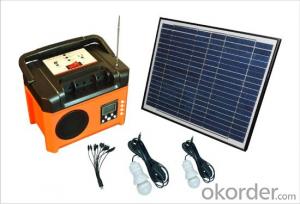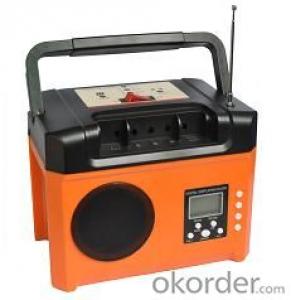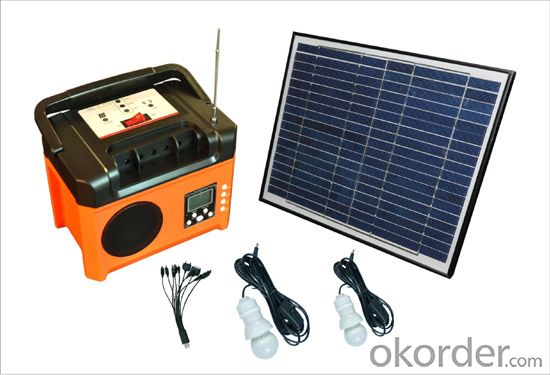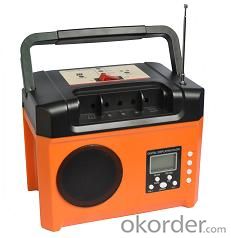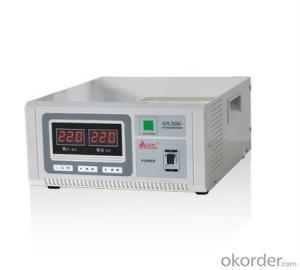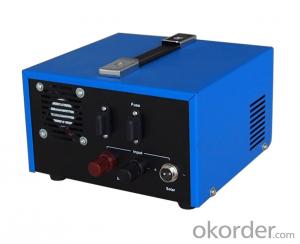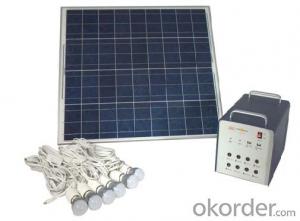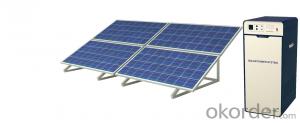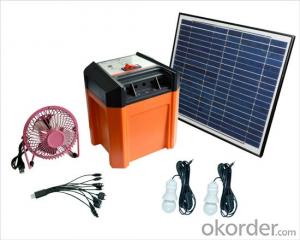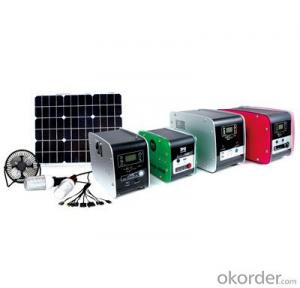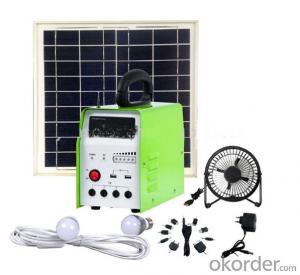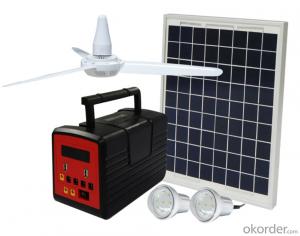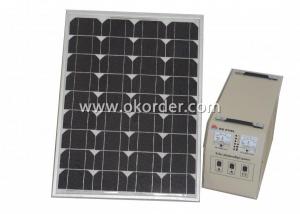Solaron Solar Energy Systems - Solar Power System with FM Radio, Built-in Battery, and USB
- Loading Port:
- Shekou
- Payment Terms:
- TT OR LC
- Min Order Qty:
- 50 unit
- Supply Capability:
- 5000 unit/month
OKorder Service Pledge
OKorder Financial Service
You Might Also Like
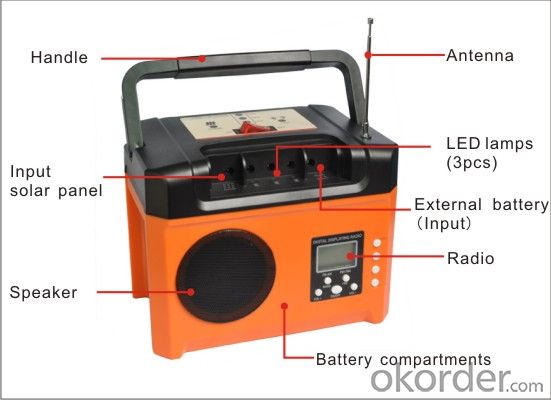
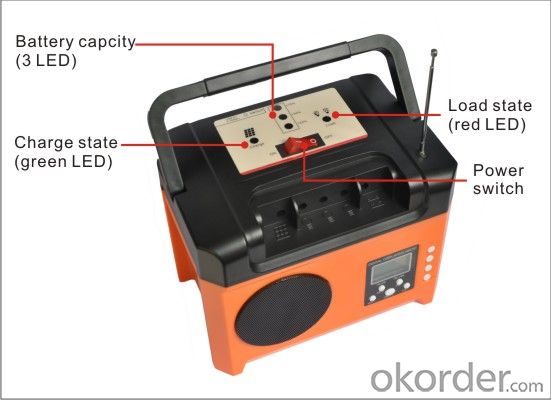
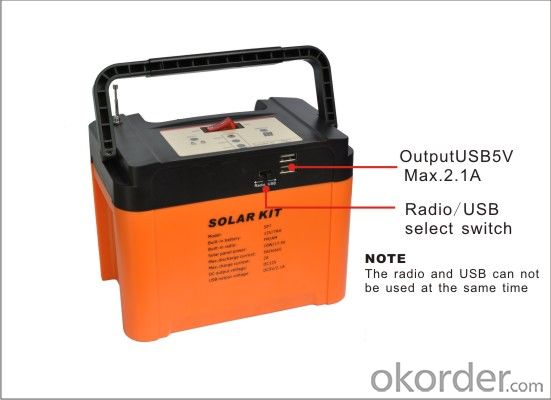
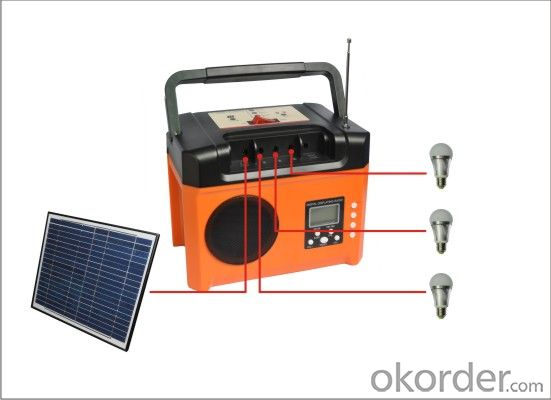
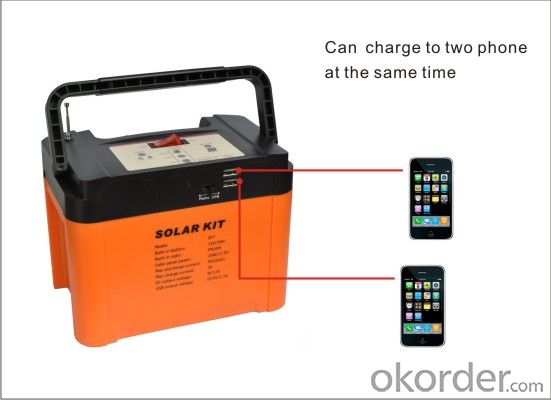
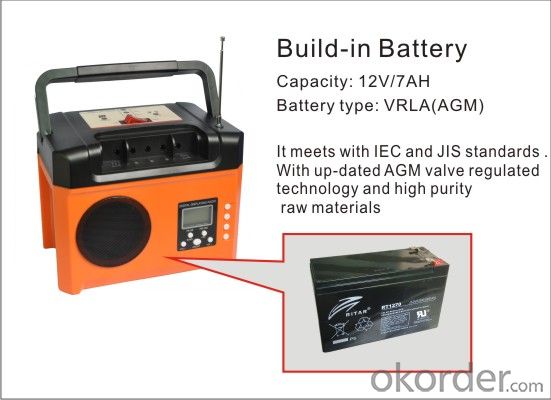
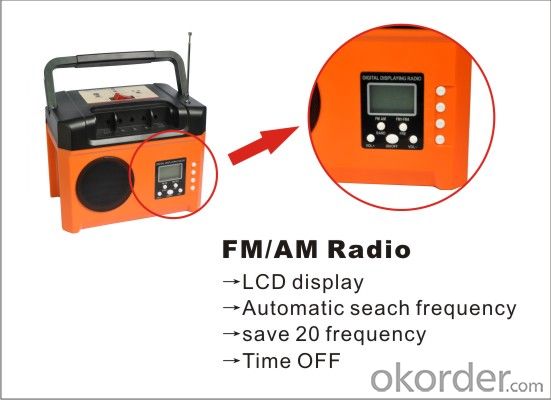
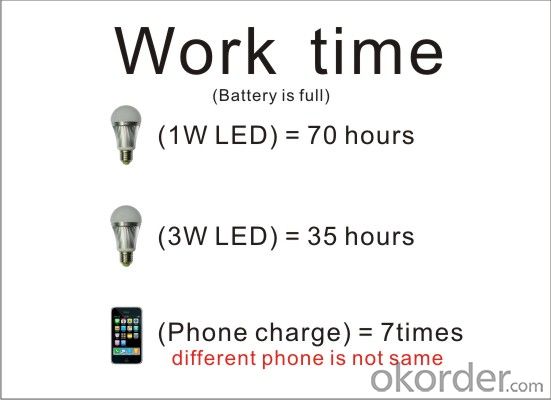
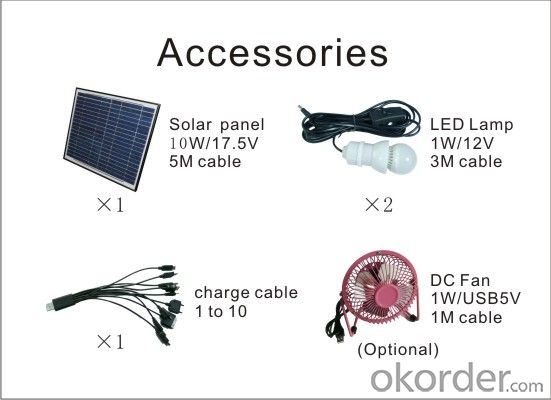
This system designed to provide DC power supply for power lighting,mobile phone charging,run the DC Fan and Radio,etc
Built-in maintenance-free Lead-acid battery
Build-in FM/AM Radio
Adopt the latest PWM Control modulation,real time display of battery capacity and load status.
With several output socket,can output voltage DC 12V and DC 5V at the same time.
It can charged by solar panel
Voice warning and together LED indicator shows the battery get low.
Bulit-in battery capacity:12V/7AH
Solar panel power:10W/17.5V
Max.discharge current(total):5A
Max.charge current:2A
DC Output voltage:DC12V
Weight:2.5KG
Work temperature:-20-40
USB output voltage:DC5V/2.1A
DC socket:DC2.5mm
- Q: Can solar energy systems be used in areas with limited construction materials?
- Yes, solar energy systems can be used in areas with limited construction materials. Solar panels can be installed on rooftops or mounted on frames, requiring minimal construction materials. Additionally, small-scale solar systems such as solar lanterns or portable solar chargers can be used in areas with limited construction materials. These systems provide a sustainable and reliable source of energy, even in remote or resource-constrained locations.
- Q: Can a solar energy system be installed on a community center or clubhouse?
- Yes, a solar energy system can definitely be installed on a community center or clubhouse. In fact, community centers and clubhouses are ideal locations for solar installations due to their large roof spaces and high energy consumption. By installing solar panels on the roof of a community center or clubhouse, the facility can generate clean and renewable electricity to power its operations. Solar energy systems can help reduce electricity bills, lower carbon emissions, and promote sustainable development in the community. Additionally, solar panels can be combined with battery storage systems to store excess energy produced during the day for use during the night or in times of high demand. Overall, installing a solar energy system on a community center or clubhouse is a great way to showcase environmental leadership and inspire others in the community to embrace renewable energy.
- Q: How does the efficiency of solar panels vary across different temperatures?
- The efficiency of solar panels typically decreases as the temperature increases.
- Q: Can solar energy systems be integrated into building design?
- Building design can include the integration of solar energy systems. This approach is increasingly popular and is considered both sustainable and cost-effective for generating electricity. There are multiple ways to incorporate solar energy systems, such as using rooftop solar panels, solar facades, or solar windows. The most common method is installing rooftop solar panels. These can be standalone structures or integrated into the roof itself. They capture sunlight and convert it into electricity, which can power the building or be fed back into the grid. Solar facades are another option. These involve placing solar panels on the outer walls of buildings. Besides generating electricity, they also act as a protective layer, reducing heat gain and improving energy efficiency. Solar windows are a new development in building design. These windows have built-in transparent solar cells that capture sunlight and generate electricity while still allowing natural light to enter the building. They have the potential to revolutionize building design by seamlessly integrating renewable energy generation into the building envelope. Integrating solar energy systems into building design offers several advantages. Firstly, buildings can generate their own electricity, reducing reliance on fossil fuels and lowering utility bills. This also contributes to reducing greenhouse gas emissions and creating a cleaner environment. Additionally, solar energy systems can enhance the aesthetic appeal of buildings, making them visually striking examples of sustainable architecture. In conclusion, solar energy systems can be integrated into building design. With options like rooftop solar panels, solar facades, and solar windows, buildings can generate clean, renewable electricity, reduce their carbon footprint, and contribute to a more sustainable future.
- Q: Can solar energy systems be used for powering medical equipment in remote areas?
- Yes, solar energy systems can be used for powering medical equipment in remote areas. Solar panels can generate electricity from sunlight, which can be stored in batteries for later use. This renewable energy source is reliable and can provide power to medical equipment, such as refrigerators for storing vaccines, diagnostic machines, lighting, and other essential devices, even in areas without access to the grid. Solar energy systems are a sustainable solution that can greatly improve healthcare access and outcomes in remote regions.
- Q: Are there any limitations to installing a solar energy system in a homeowner's association?
- Yes, there can be limitations to installing a solar energy system in a homeowner's association (HOA). While many HOAs have embraced renewable energy and have adopted guidelines to facilitate solar installations, some may have restrictions or limitations in place. One limitation is that the HOA may have specific aesthetic guidelines or architectural standards that must be adhered to. This means that the solar panels may need to be installed in a way that aligns with the overall design and appearance of the community. In some cases, this could mean limitations on the size, location, or visibility of the panels. Another limitation is the potential impact on property values. While solar energy systems are generally seen as a desirable feature, there could be concerns among some homeowners about the impact on property values. In some cases, the HOA may require an approval process, including a review by a committee or board, before allowing installation. Additionally, there may be limitations related to the structural integrity of the property. Solar panels can be heavy, and certain roofs or structures may not be able to accommodate the added weight. The HOA may require a structural assessment or engineering report to ensure that the installation will not compromise the integrity of the building. Lastly, there may be limitations related to legal and regulatory requirements. Depending on the jurisdiction, there may be specific permits, licenses, or agreements required for solar installations. The HOA may need to ensure that all necessary documentation and approvals are obtained, which can add time and complexity to the installation process. Overall, while many HOAs are supportive of solar energy systems, it is important for homeowners to review their specific HOA guidelines and engage in open communication with the association to understand any limitations or requirements that may be in place.
- Q: Can solar panels be installed on vertical surfaces?
- Yes, solar panels can be installed on vertical surfaces. While the most common and efficient installation method is to mount solar panels on rooftops or tilted surfaces facing the sun, there are also specialized solar panels designed specifically for vertical installations. These panels, known as vertical or facade solar panels, are typically designed with a frameless and lightweight design to be easily mounted on vertical surfaces like walls or building facades. Vertical solar panels can be a great solution for buildings with limited roof space or for those looking to maximize energy production on all available surfaces. However, it's important to note that vertical installations may not be as efficient as traditional rooftop installations due to the reduced exposure to sunlight. The angle and orientation of the surface, as well as potential shading from nearby structures or trees, can also impact the performance of vertical solar panels. Nevertheless, advancements in solar technology and design have made vertical installations more viable and efficient than ever before. With proper planning and consideration of factors like surface tilt, orientation, and shading, solar panels can be successfully installed on vertical surfaces to harness clean and renewable energy.
- Q: Can a solar energy system be installed on a sports field or stadium?
- Sports fields and stadiums have the capacity to install solar energy systems. In fact, many of these facilities worldwide have already adopted this renewable energy source to fulfill their energy requirements. Typically, these systems consist of solar panels that are positioned on the roofs or surrounding areas of the facility. The expansive surface area of sports fields and stadiums often makes them prime locations for solar panel installations. The advantages of incorporating a solar energy system into a sports field or stadium are plentiful. Firstly, it enables the facility to generate clean, renewable energy, reducing its dependence on traditional fossil fuels and diminishing its carbon footprint. This aligns with the growing global concern for environmental sustainability. Moreover, solar energy systems can yield substantial long-term energy cost savings for sports facilities. The electricity produced by solar panels can be utilized to power various aspects of the stadium, including lights, scoreboards, sound systems, and other equipment. Any excess energy can be redirected back into the power grid, potentially generating revenue for the facility through net metering or feed-in tariffs. Furthermore, installing a solar energy system on a sports field or stadium can serve as a powerful symbol of environmental awareness and sustainability. It has the potential to inspire and educate fans, athletes, and the broader community about the significance of renewable energy and the capacity of solar power to meet our energy needs. In conclusion, it is indeed feasible to install a solar energy system on a sports field or stadium, offering numerous advantages such as the generation of clean and renewable energy, reduced energy costs, and the promotion of environmental sustainability.
- Q: How does the performance of solar panels degrade over time?
- The performance of solar panels degrades over time due to several factors. One of the main reasons for degradation is the natural wear and tear that occurs as solar panels are exposed to environmental elements such as sunlight, temperature fluctuations, and weather conditions. Over time, these factors can cause a gradual breakdown of the materials used in solar panels, leading to a decrease in their efficiency. Another factor that contributes to the degradation of solar panels is known as the "light-induced degradation" or "LID". LID occurs in the initial period after the installation of solar panels, where the efficiency of the panels can decrease by up to 2-3%. This is caused by the interaction between sunlight and the boron-oxygen defects within the silicon used in the panels. However, this degradation stabilizes after a certain period, usually within a few months. Furthermore, the accumulation of dirt, dust, and debris on the surface of solar panels can also impact their performance. This build-up reduces the amount of sunlight reaching the solar cells, thus reducing their efficiency. Regular cleaning and maintenance are necessary to mitigate this issue. In addition to these physical factors, the overall performance of solar panels can also degrade due to electrical factors. Over time, the electrical connections within the panels may loosen or corrode, leading to a decrease in their efficiency. This is why routine inspections and maintenance are crucial to identify and rectify any electrical issues that may arise. It is important to note that despite the degradation, solar panels are designed to have a long lifespan. Most manufacturers provide warranties for 25 years or more, ensuring that the panels will continue to generate electricity efficiently throughout their lifetime. Regular maintenance, cleaning, and monitoring can help minimize degradation and ensure optimal performance for many years.
- Q: Can solar energy systems be installed on roofs?
- Yes, solar energy systems can be installed on roofs. In fact, rooftops are one of the most common locations for solar panel installations, as they offer ample space and direct access to sunlight. This allows for efficient harnessing of solar energy to generate electricity or heat water.
Send your message to us
Solaron Solar Energy Systems - Solar Power System with FM Radio, Built-in Battery, and USB
- Loading Port:
- Shekou
- Payment Terms:
- TT OR LC
- Min Order Qty:
- 50 unit
- Supply Capability:
- 5000 unit/month
OKorder Service Pledge
OKorder Financial Service
Similar products
Hot products
Hot Searches
Related keywords
